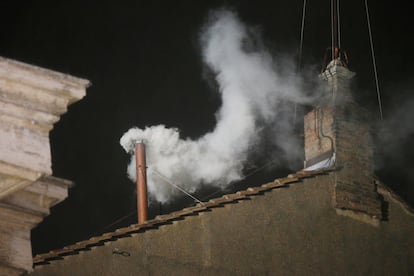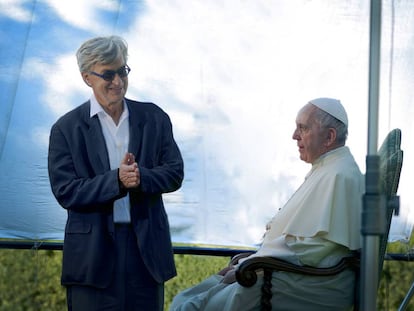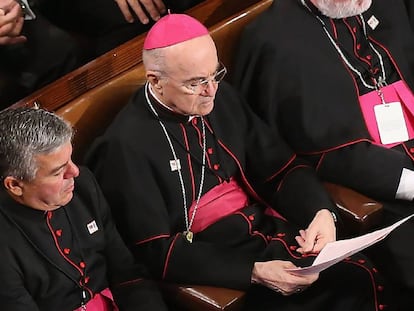The corrupt Pope who sold his office for money and forced the Church to create the conclave
The death of Pope Francis has brought the documentary series ‘Pope: The Most Powerful Man in History’ back into the spotlight. One of its episodes addresses the controversial figure of Benedict IX


With the death of Pope Francis on Monday at the age of 88, on-demand streaming platforms have brought content from their respective catalogs related to the historical figure of the pontiff to the forefront. One of those that has been resurrected is the documentary series Pope: The Most Powerful Man in History. Consisting of six episodes and narrated by Liam Neeson, this 2018 non-fiction series produced by CNN reviews the origins of what is considered one of the most influential positions in human history. And it analyzes how 12 apostles became approximately 1.2 billion Catholics.
In its second episode, Pope: The Most Powerful Man in History addresses the controversial voluntary resignation of Benedict XVI in 2013. Despite being a very rare move — it had only happened a handful of times in more than 2,000 years — it brought with it the arrival of Pope Francis. Father James M. Weiss, professor of theology at Boston University and Episcopal priest, explains in the documentary how the Argentine inherited from his predecessor “financial chaos, the chaos of sexual abuse in the Catholic Church, and administrative chaos.”
The CNN series connects the story of this resignation with a much more controversial one, that of Benedict IX, which gave rise to now-iconic processes, such as the conclave and the white smoke, which are used to elect each new pope. Benedict IX was a medieval nepobaby who held the office up to three times during the 11th century. The nephew of several popes, he was a member of the most powerful family in Rome, who bought the position for him. Benedict IX took office in 1032, while practically a teenager. “At that time, the papacy was the legal center of the Western world,” Weiss recalls on camera.
His corrupt reign led him to participate in all kinds of crimes and to damage the image of the Church to such an extent that the Catholic cardinals decided to force him to resign. To convince him, they offered him a generous sum of money, which some historians estimate at 1,500 pounds of gold. His successor, Sylvester III, lasted barely six months in office. Benedict IX resorted to a powerful army assembled by his influential family to forcefully overthrow him and return to power. A few days after taking office by force, he decided he would rather leave to marry his cousin and chose his godfather as his successor: Gregory VI. The marriage did not take place, and, once again, Benedict IX decided to resume his role as pope.
As Susan Wise Bauer, a writer trained in theology and art and author of The History of the Medieval World recalls, this decision placed the Church before three candidates claiming to be the successor to Saint Peter, a conflict that, once again, was resolved by military means and which, once again, Benedict IX won with the support of his powerful family. At that moment, the cardinals decided to create a clear process for electing the future pontiff.

It was the first step toward what we know today as the conclave and the white smoke. During those years, there were several attempts at an electoral process that all ended up rigged, until Pope Gregory X made a decision in the 13th century. He ordered a meeting of cardinals to be held behind closed doors, locked, and with no outside contact for voters. The name of the assembly comes from the Latin cum-clavis (with a key): conclave.
The process is well explained in both the CNN documentary and the film Conclave. The deliberation begins with the presentation of the candidates. For one of them to be elected, they need the support of two-thirds of the voters. If the candidate with the most votes doesn’t achieve that number, the pieces of paper containing the anonymous votes are burned. In the past, they were mixed with wet straw to create a black smoke, indicating that a new round of voting must begin if a consensus isn’t reached. When, at the end of a round, one of the candidates’ names appears on more than two-thirds of the ballots, they are burned without any condiments, causing the smoke to rise white and producing the white smoke that announces the arrival of a new pontiff.
Currently, chemicals are used to color the smoke that announces the result of each round of voting. Since John Paul II’s mandate, the cardinals participating in the conclave have been housed in the Santa Marta residence, built in the Vatican, to make this decision.
Sign up for our weekly newsletter to get more English-language news coverage from EL PAÍS USA Edition
Tu suscripción se está usando en otro dispositivo
¿Quieres añadir otro usuario a tu suscripción?
Si continúas leyendo en este dispositivo, no se podrá leer en el otro.
FlechaTu suscripción se está usando en otro dispositivo y solo puedes acceder a EL PAÍS desde un dispositivo a la vez.
Si quieres compartir tu cuenta, cambia tu suscripción a la modalidad Premium, así podrás añadir otro usuario. Cada uno accederá con su propia cuenta de email, lo que os permitirá personalizar vuestra experiencia en EL PAÍS.
¿Tienes una suscripción de empresa? Accede aquí para contratar más cuentas.
En el caso de no saber quién está usando tu cuenta, te recomendamos cambiar tu contraseña aquí.
Si decides continuar compartiendo tu cuenta, este mensaje se mostrará en tu dispositivo y en el de la otra persona que está usando tu cuenta de forma indefinida, afectando a tu experiencia de lectura. Puedes consultar aquí los términos y condiciones de la suscripción digital.
More information
Archived In
Últimas noticias
ICE raids trigger school absenteeism and traumatize children: ‘They have been forced to leave their childhood behind’
The guardians of the meteorites of the Argentine Chaco
Helen Levitt, the photographer who captured the theater of the everyday
Maude Apatow, from acting in ‘Euphoria’ to directing: ‘There are many films that you can tell weren’t written by someone young’
Most viewed
- Christian Louboutin: ‘Young people don’t want to be like their parents. And if their parents wear sneakers, they’re going to look for something else’
- US sanctions against jailed cartel leader ‘El Marro’ highlight Mexico’s lack of control over its prisons
- The low-cost creative revolution: How technology is making art accessible to everyone
- Liset Menéndez de la Prida, neuroscientist: ‘It’s not normal to constantly seek pleasure; it’s important to be bored, to be calm’
- Cartels in Mexico take a leap forward with narco-drones: ‘It is criminal groups that are leading the innovation race’










































